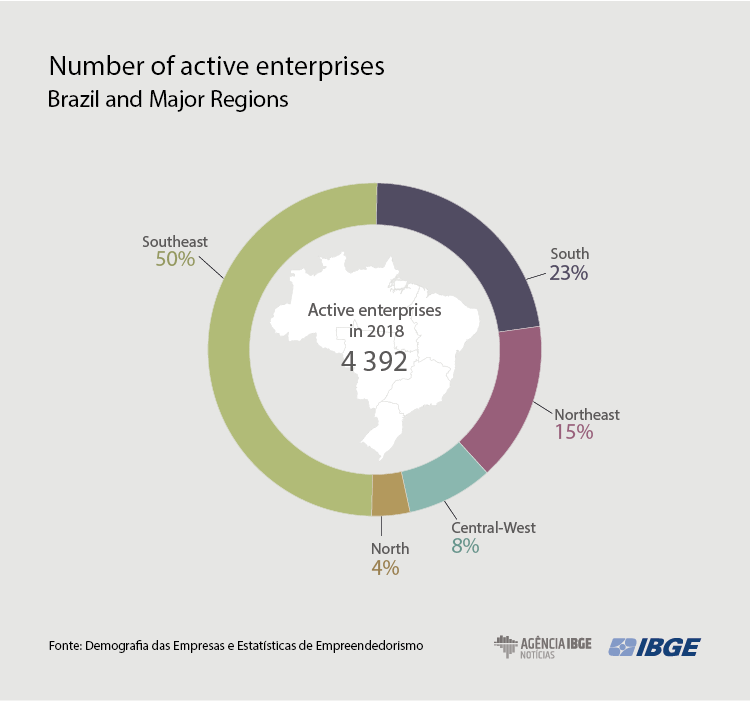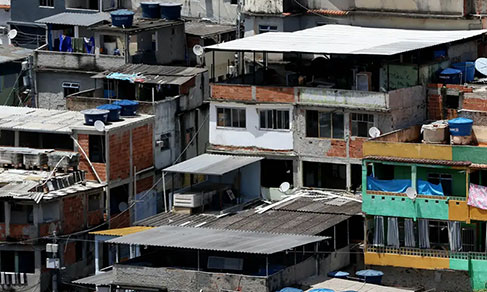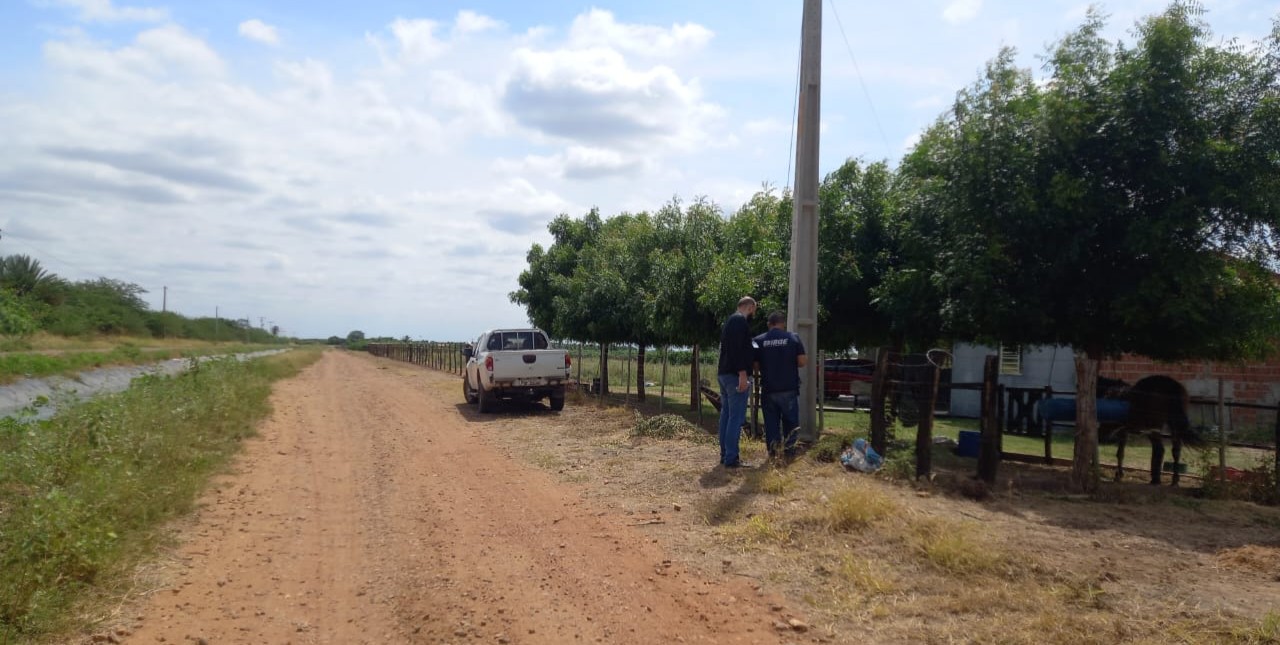Demography of enterprises
With a survival rate of 84.1%, Brazil has negative balance of enterprises in 2018
October 22, 2020 10h00 AM | Last Updated: October 23, 2020 11h20 AM
Highlights
- The survival rate corresponded to 3.7 million enterprises.
- The entry rate was 15.9% (697.1 thousand) and the exit rate stayed at 17.4% (762.9 thousand), producing a balance of less 65.9 thousand enterprises.
- Surving enterprises employed 97% of the salaried persons, most of them men (60.8%) and with higher education (15.2%).
- Between 2013 and 2018, 382.2 thousand enterprises closed in Brazil.
- Number of high-growth enterprises advanced 11.9%, interrupting five consecutive years of drop.
- Within this segment, the “gazelles”, with up to 5 years of age, added up to nearly 2.6 thousand.

According to the Demography of Enterprises and Entrepreneurship Statistics study, released today (22) by the IBGE, the balance between enterprises created and closed in Brazil was negative in 2018. While 697.1 thousand started their business, 762.9 thousand companies closed their activities that year, producing a balance of less 65.9 thousand enterprises. Brazil lost 382.2 thousand enterprises between 2013 and 2018.
The survey only takes into account the corporate entities, excluding Individual Micro-entrepreneurs (MEIs), public administration offices, non-profit entities and international organizations operating in Brazil.
In 2018, the Central Register of Enterprises - Cempre added up to 4.4 million active enterprises in Brazil, which employed 38.7 million persons. Of this total, 32.3 million (83.5%) were salaried and 6.4 million (16.5%), partners or owners. The average age of these companies was 11.6 years.

Of the total active enterprises, 3.7 million were already active before 2018, which represents a survival rate of 84.1%, 0.7 p.p. lower than that of the previous year. Other 15.9% (697.1 thousand) became active in 2018, being that 536.0 thousand were born that year and 161.1 thousand re-activated their activities. The other ones (762.9 thousand) closed their activities, an exit rate of 17.4%.
The reduction of 1.5% in the number of enterprises in 2018, compared with the previous year, was mainly leveraged by the segment of Trade; repair of motor vehicles and motorcycles, which registered a negative balance of 88.7 thousand enterprises. Although with an inexpressive participation, Health and social services was the sector that mostly contributed to the balance of enterprises (23.7 thousand).
"The behavior of exits and entries of enterprises has a direct relation to the economic activity in Brazil. Only in 2014, 218 thousand closed their doors. This movement continued in the following years, though at a lower level, reflecting the economic activity in the period, which has been weak ever since," assesses Thiego Gonçalves Ferreira, manager of the study.

The survey also shows that the salaried employed personnel grew 1.3% (419.8 thousand) in 2018. They were employed, above all, by the surviving enterprises, which employed 97.3% of the salaried persons. In these enterprises, the share of men was 60.8% against 39.2% of women, and the percentage of employees with higher education reached 15.2%.
"Men are also the majority in the new enterprises and in those that closed their doors. Yet, the share of persons with a higher schooling level is lower. It leads us to imply that the population with higher schooling level is more resistant to join these enterprises, choosing the survivors, since they also pay better," commented Ferreira.
In five years, only 36.3% of the enterprises survived and were operating in 2018. The larger the size, the higher the survival rate. In that year, 96.5% of the entities with more than 10 employees survived. Among those that did not have any salaried person, the survival rate was 74.4%. Among those between one and nine salaried workers, the rate hit 91.4%.
Only 25.3% of the branches reached 10 years
The study also unveils that only 25.3% of the local units (branches) of the enterprises born in 2008 survived and were operating in 2018. The survey detailed these data by Federation Unit for the first time ever. They show, for example, that while the survival rate of the enterprises in the tenth year of life changed 16.4% in Amazonas, it was nearly the double in Santa Catarina (32.1%).
"The micro-economic environment in the Federation Units, like management capacity and access to credit, is quite different. In Amazonas, the entry and exit rates of enterprises were higher, which points out that opening an enterprise is easier, but it is also difficult to manage them. The opposite happened in Santa Catarina, where entrepreneurs seem to have a more favorable scenario and greater management capacity," analyzed Ferreira
High-growth enterprises advance 11.9% in 2018
In 2018, the number of high-growth enterprises increased 11.9%, adding up to 22.7 thousand and interrupting five consecutive years of drops. Nevertheless, this is the third lowest figure in the time series. The highest value was recorded in 2012 (35.2 thousand) and the lowest one, in 2017 (20.3 thousand).
High-growth enterprises are those with at least 10 salaried employees and that increased their personnel above 20% per year, for three consecutive years. Such growth is associated to entrepreneurship.
These high-growth enterprises represented 1.0% of the active enterprises and 5.0% of the enterprises with 10 or more employed persons. They accounted for 11.2% of the salaried persons and for the payment of 9.1% of the salaries and other compensation.
Thiego Ferreira notes that sustaining the high growth is quite rare among enterprises. "The survey showed that only 5.6% of the enterprises that highly grew between 2008 and 2013 repeated this achievement five year later. It is a low rate. It is even lower when we look at the 10-year horizon (3.1%). It shows how hard is to grow again later," said him.
Nearly 2.6 thousand were "gazelle" enterprises.
Of the total high-growth enterprises, 11.4% (2,597 thousand) were called "gazelles", which have up to five years of age. They also grew 7.2% in 2018. They are enterprises that employed 198.8 thousand persons and paid R$4.6 billion in salaries and other compensation, the equivalent to an average monthly salary of 2.1 minimum wages.



















